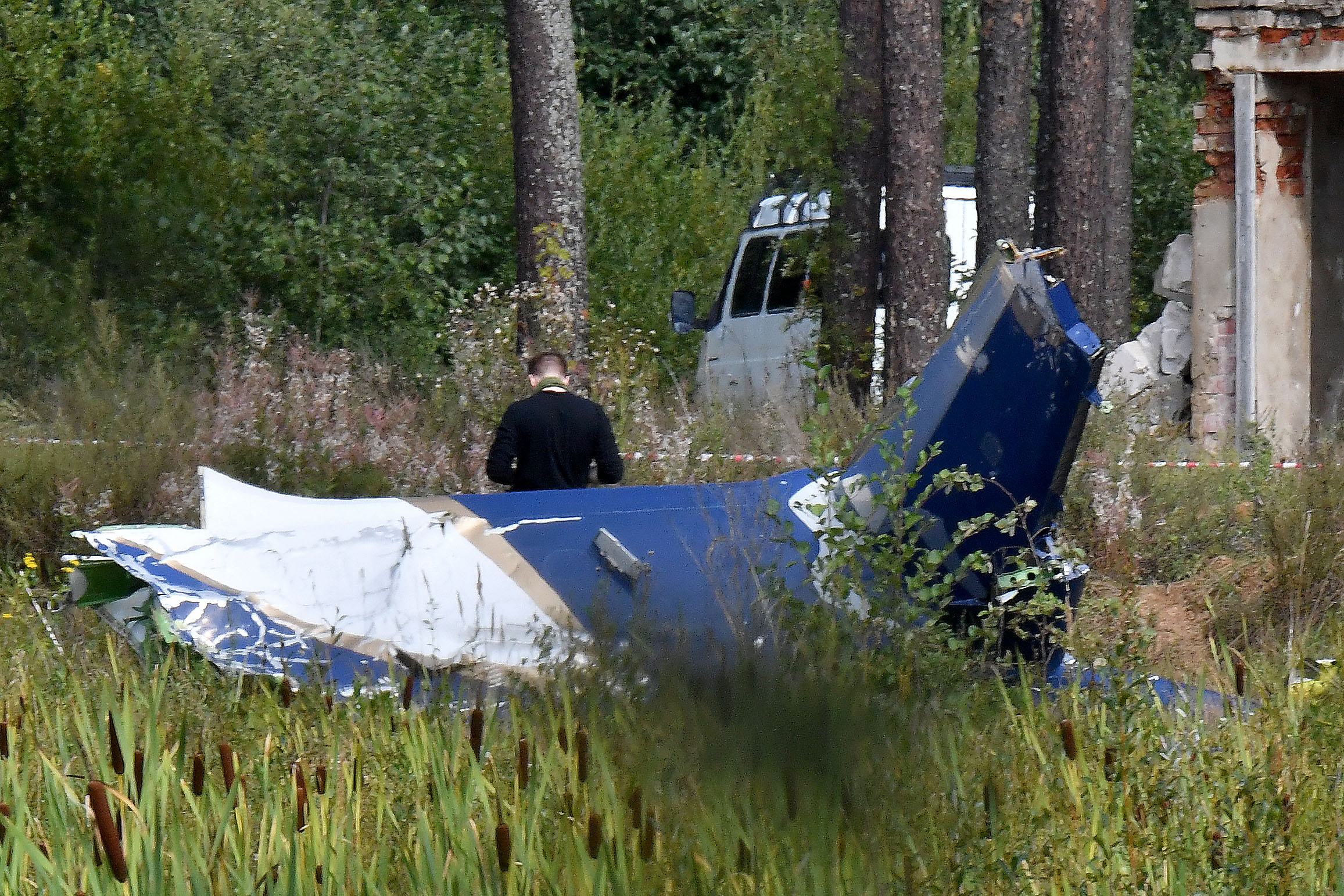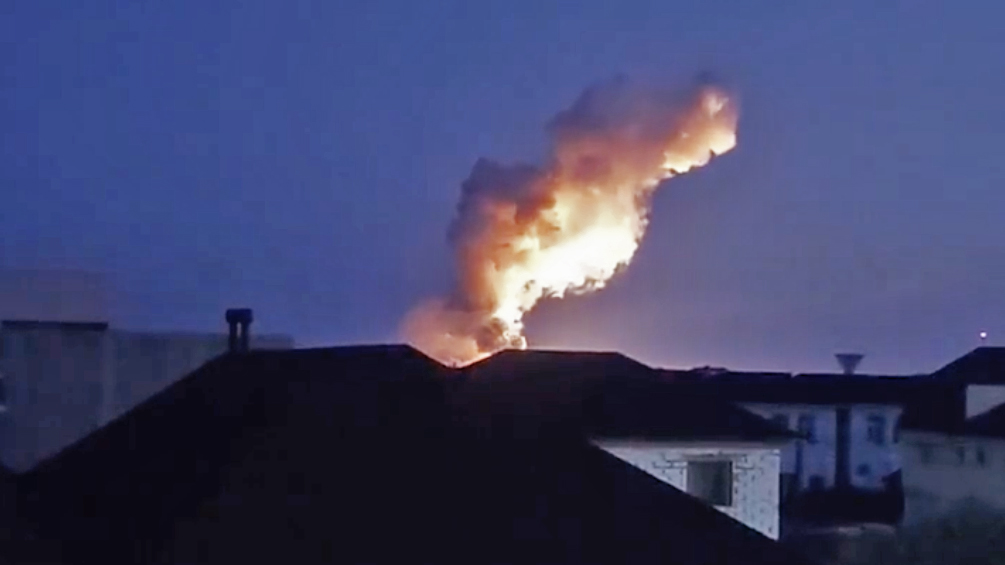Ukraine claims to have destroyed another example of the advanced Russian S-400 Triumpf air defense system, near the town of Yevpatoriya in occupied Crimea. While you can read more about the wider context of the latest attack here, a Ukrainian intelligence source told the Reuters news agency that a combination of missiles and drones was used in the operation, which took place in the early hours of Thursday morning.
According to the Ukrainian account, drones were first used to attack the surveillance radar of the Triumf system, leaving it open to destruction by missiles. The same intelligence source said that the Ukrainian Navy fired two surface-to-surface versions of the Ukrainian-made Neptune anti-ship cruise missiles, taking out the system’s launch complexes. You can read more about the modifications to the Neptune to attack ground targets, and their wider significance, here.
Videos posted to social media showed a large explosion purporting to be in the vicinity of Yevpatoriya.
On its Telegram channel for the occupied region of Crimea, Ukrainian state broadcaster Suspilne reported that “Yevpatoria residents do not understand what is happening. The occupation authorities do not explain, and ambulances and the police are driving around the city.”
Meanwhile, Russia claimed its air defenses had shot down 11 drones sent to attack targets in Crimea overnight.
By apparently taking out a critical part of Crimea’s air defenses, the operation will have left the peninsula even more vulnerable to similar attacks, by both drones and missiles. The day before this strike, an apparent combined cruise missiles and drone boat attack inflicted serious damage on a Russian Navy Kilo class submarine and a Ropucha class landing ship in the port of Sevastopol, as you can read about here. The latest imagery from Sevastopol suggests that both those vessels were put out of action, potentially permanently.
Before we head into the latest news from Ukraine, The War Zone readers can catch up on our previous rolling coverage here.
The Latest
Another Black Sea Fleet vessel has reportedly come under attack by Ukraine, although it remains unclear whether any damage was inflicted. The Russian Ministry of Defense has said that it destroyed five Ukrainian drone boats that were trying to attack the Project 22160 large patrol ship Sergei Kotov in the Black Sea early on Thursday. The ministry said the unmanned surface vessels (USVs) were “destroyed by fire from the ship’s standard weapons,” although this cannot be independently verified.
The Sergey Kotov is one of four of the very modern Project 22160 vessels currently active with the Black Sea Fleet and has apparently come under attack before. In July, the Russian Ministry of Defense claimed that it destroyed two Ukrainian USVs that were engaged in an attack on the Kotov, as you can read more about here.
The Project 22160 ships, which displace around 1,965 tons and are 300 feet long, have a standard armament that includes a single 76mm automatic gun and a pair of 14.5mm heavy machine guns.
Britain’s most senior military officer, Sir Tony Radakin, is the latest Western official to wade into the debate on the progress that is characterizing Ukraine’s counteroffensive, which was launched in June.
Speaking at the Defense & Security Equipment International (DSEI) tradeshow in London, Radakin pointed to Ukraine’s progress in the counteroffensive and said that it “holds the initiative.” Radakin, who has a role advising Ukraine’s most senior commander Valerii Zaluzhnyi, added that Ukraine is currently “pushing Russia back.”
Radakin denied that the Ukrainian counteroffensive was struggling, noting that “in the north, they are holding and fixing Russian forces there and in the south they are making progress between 10 and 20 kilometers [6 and 12 miles] depending on how you judge it.”
“The idea that war is neat and tidy, and you can plan and predict it to the nth degree is nonsense,” Radakin added.
A recently emerged video purportedly provides a first look at one of the tracked 9K35 Strela-10 (SA-13 Gopher) short-range air defense systems supplied to Ukraine by Jordan. The Strela-10 uses a highly mobile, tracked MT-LB chassis and can fire a variety of infrared-guided missiles, including the 9M37 and 9M333 families, which can engage targets out to a range of 3.1 miles. Prior to the start of the latest hostilities, Ukraine was thought to have at least 75 examples of the Strela-10 in service. At least six examples of the SA-13 have also been provided by the Czech Republic.
An aviation security consultant has suggested that the business jet carrying Yevgeny Prigozhin, the boss of the Wagner mercenary group, was brought down by an air-to-air missile. This is the latest development surrounding the death of Prigozhin, killed when the jet came down in Russia’s Tver region, northwest of Moscow, last month.
Eric Schouten of Dyami Strategic Security Services said his team has concluded that an air-to-air missile was the likely cause of the loss of the Embraer Legacy 600 that was also carrying other members of the Wagner Group, when it came down on August 23.
While the Putin administration denied suggestions that it was responsible for Prigozhin’s deaths, rumors very quickly began to circulate around what Wagner Group adherents said was a Kremlin-orchestrated assassination.
If Schouten’s hypothesis is right, it would point squarely to an assassination, something that is hardly unheard of when it comes to enemies of the Putin regime. As the architect of an attempted coup in Russia in late June, Prigozhin was clearly a marked man.
Schouten, whose background is in the Dutch intelligence services, said that the theory of an onboard explosive device could be ruled out since large sections of the bizjet’s pressurized hull remained intact among the wreckage. Another option, a surface-to-air missile, was also unlikely, Schouten said since a launch would almost certainly have been detected.

Fueling suspicions about an inside job is the fact that Russia’s Interstate Aviation Committee was apparently instructed not to investigate the crash, in a break with standard procedures. Instead, Russia has begun a criminal investigation.
At this stage, Schouten’s theory is just that, but it seems inevitable that rumors will continue to swirl around this incident for some time to come.
In the follow-up to North Korean leader King Jong Un’s meeting with President Vladimir Putin in Vladivostok, earlier this week, the Russian leader has “gratefully accepted” an invitation to visit North Korea, the Kremlin has confirmed.
The exact outcome of the meeting in the Russian Far East — and especially its relevance to the war in Ukraine — has not been disclosed. However, U.S. officials, in particular, have expressed concerns that North Korea may be closer to providing arms to Russia, while Moscow could supply Pyongyang with advanced missile technology in return.
Kremlin spokesperson Dmitry Peskov described Kim’s meeting with Putin as “timely, useful, and constructive.” At the same time, he also confirmed that the Russian foreign minister, Sergei Lavrov, will also visit North Korea, in October.
In the latest wave of Russian drone strikes against Ukraine, authorities in Kyiv claim that air defenses brought down 17 out of 22 drones sent over its territory overnight into Thursday.
“On the night of September 14, between 9:00 pm to 2:30 am, the Russian invaders attacked Ukraine with several groups of Shahed-136/131 types from three directions,” the Ukrainian Air Force stated on the Telegram messaging app.
For their part, the Russian military and media reported that their anti-aircraft units downed Ukrainian drones in two regions of southern Russia over the same time period.
According to local officials and the Russian defense ministry, five drones were brought down over the Bryansk region and one over the Belgorod region, both of which border Ukraine. No casualties or damage were reported.
Russian drones were also active against ports along the Danube River, used by Ukraine for vital grain exports. According to the local governor of the Odesa region, Oleg Kiper, the port of Izmail in southern Ukraine was attacked, injuring several people, and starting a fire. Agence France-Presse reports that the Ukrainian military claimed 32 drones were downed during the attack.
Kiper provided the following statement on social media:
“A total of seven civilians were injured as a result of Russian attack drones in the Izmail district. Six people in Reni and one in Izmail. Damage to port and other civil infrastructure was recorded.”
Ports along the Black Sea and Danube River have come under repeated Russian attack since Moscow withdrew from a U.N.-brokered deal allowing safe grain shipments earlier this summer. Particularly hard hit has been grain-exporting infrastructure in the southern Odesa and Mykolaiv regions.
Ukraine’s infrastructure minister, Oleksandr Kubrakov, recently said that more than 100 Ukrainian port infrastructure facilities have been damaged by Russian attacks since July 18, when Russia pulled out of the grain deal. At the same time, Ukrainian grain exports had dropped by almost 3 million tons, Kubrakov said.
Finally, it remains unclear what, if any heavy weapons or ammunition Russia secured after the summit between President Vladimir Putin and Kim Jong Un. However, the Kremlin has confirmed that the two leaders did each receive a rifle, with examples being exchanged between them as gifts.
Kremlin spokesperson Dmitry Peskov said that Putin “gave [Kim] a rifle from our production of the highest quality. In turn, he also received a North Korean-made rifle.”
Other gifts for Kim from Putin included “a glove from a space suit that has been in space several times,” Peskov said, according to AFP, raising speculation that North Korea could be set for involvement in upcoming Russian space missions.
That’s it for now. We’ll update this story when there’s more news to report about Ukraine.
Contact the author: thomas@thewarzone.com
